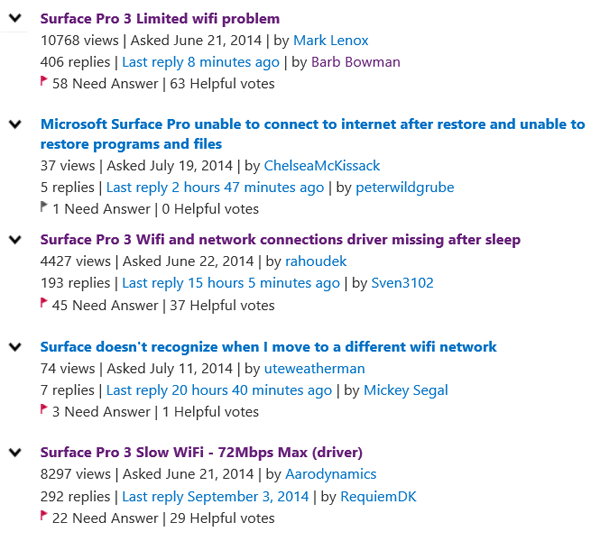

Others report even less that the 12.49 speed I can achieve. Still getting great speeds on 5 GHz, but totally dismal speeds on 2.4 GHz.

Testing with my ASUS ROG “desktop replacement” which has a Broadcom 802.11ac built in adapter:Īs you can see, my speed exceeds my provisioned speed. I tested with and my ISP provisioned speed is 105/10. The speeds obtained are dreadful when compared to just about any other wireless adapter on any other similarly equipped computer and far less than can be obtained when using a USB wireless 802.11ac adapter on the SP3, and using the 2.4 GHz band (as you will see).Īll of my testing was done from the same location in my home, in my living room on the first floor with the Netgear R7000 router on the 3rd floor. I’ve written about tweaks that folks can use at home, but these provide only incremental speed boosts when attached to a 2.4 GHz network using the Surface Pro 3. Given that nearly all of the public WiFi access points are 2.4GHz only (Starbucks, McDonald’s, etc.) and that the Surface Pro 3 has severe performance issues with the Marvell wireless radio when using the 2.4 GHz band, it’s easy to see why there are so many unhappy campers. Folks with single band 802.11 (2.4 GHz) routers are not going to achieve the fast speeds that 802.11ac offers. (Microsoft are you listening/reading?)Īs I’ve stated before, the very fast 802.11ac speeds only are achieved on a 5GHz SSID. I wanted to clearly frame this issue for anyone that might be interested. Microsoft Surface customers have been complaining about slow WiFi speeds using their Surface Pro 3’s in Microsoft Communities and elsewhere. Real World Data Points on Slow WiFi on Surface Pro 3 using 2.4 GHz Too bad Microsoft didn’t have the common sense to post this information in the Answers Community Forums where users are begging for relief. Adds customer-requested functionality to prefer 5Ghz connections when both a 2.4ghz and 5ghz connection are present with the same SSID.Ensures device reconnects properly to a hidden SSID using a 5Ghz DFS channel after waking from sleep.Resolves an issue connecting to Cisco 1242 access points.Ensures Infra scan list is not empty while connected to a wireless display adapter.Enables better throughput after waking from sleep and connecting to an 802.11AC network.
SURFACE PRO 3 NETWORK DRIVER UPDATE
Wireless Network Controller and Bluetooth driver update (v.135) In particular, there are some WiFi updates that hopefully will fix some of the horrific issues that have plagued some customers since launch. Some good news, Microsoft has announced upcoming updates to the Surface Pro 3 on TechNet.

Microsoft Announces Upcoming Updates to Surface Pro 3 This is especially important when using public WiFi which normally uses the 2.4GHz band. Important: If you change locations and have specified a setting other than Auto, you should change the setting back to Auto to insure connectivity “on the road”. Note that the 5GHz band is the one that provides the 802.11ac speeds. Access the dropdown list and select 5GHz if you want to connect to only the 5GHz band. Open the Driver tab and verify the versionīy default, the Band is set to Auto in the Value field. Right Click or tap and hold the Marvell AVASTAR Wireless-AC Network Controller and select PropertiesĤ. Type the words device manager on the Start Screen/search and then open device manager.ģ. If you are one of the folks that has been trying to resolve issues of connecting to 2.4GHz instead of 5 GHz on your dual band router, this new driver includes settings to fine tune your connectivity preferences.įirst, verify that you have Driver Version.
SURFACE PRO 3 NETWORK DRIVER DRIVERS
On January 15, 2015, Microsoft released a package of drivers to Windows Update that includes an updated Marvell WiFi driver for the Surface Pro 3.


 0 kommentar(er)
0 kommentar(er)
